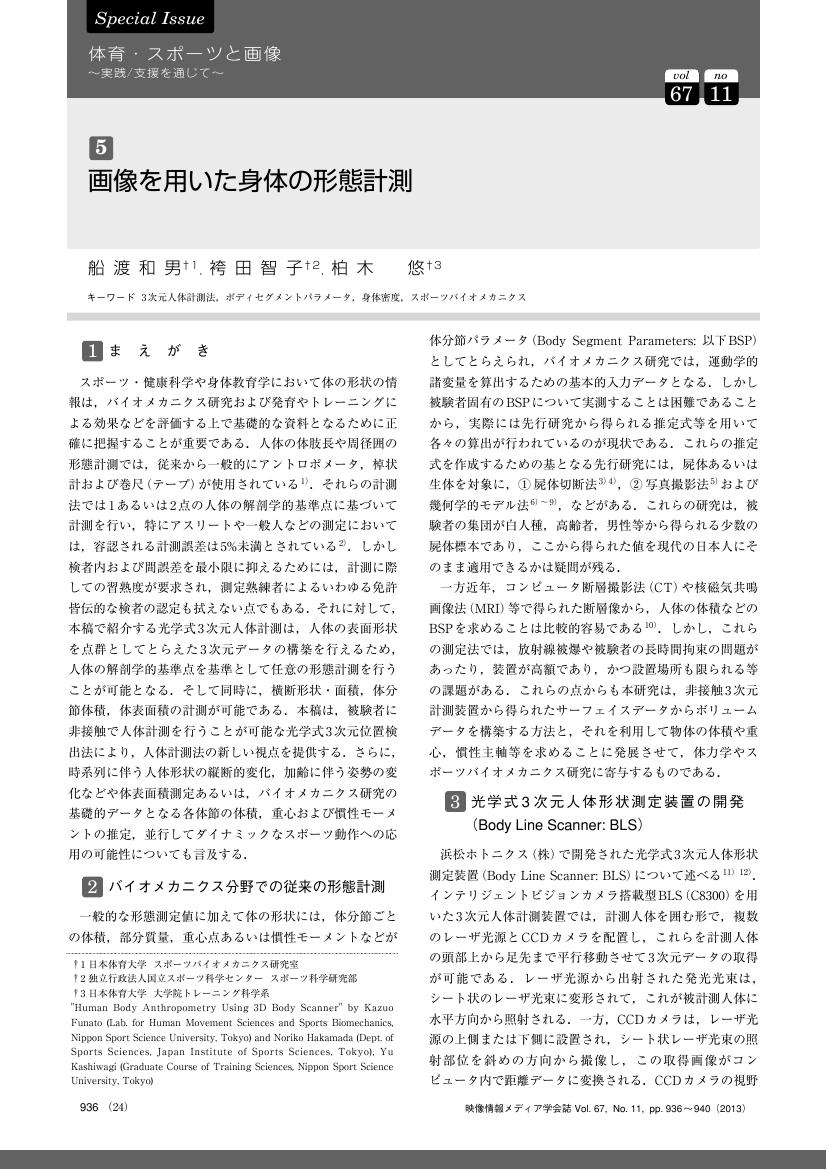23 0 0 0 OA 身体組成の評価方法間にみられる身体密度および体脂肪率の差の検討
- 著者
- 設楽 佳世 袴田 智子 大西 貴弘 池田 達昭
- 出版者
- 一般社団法人日本体力医学会
- 雑誌
- 体力科学 (ISSN:0039906X)
- 巻号頁・発行日
- vol.66, no.5, pp.369-382, 2017-10-01 (Released:2017-09-29)
- 参考文献数
- 41
- 被引用文献数
- 2
The objectives of this study were 1) to quantify the differences in body densities and percent body fat using various methods for evaluating body composition (e.g., underwater weighing (UWW), air displacement plethysmography (ADP), skinfold caliper (SKF) measurement, ultrasound (US), bioelectrical impedance analysis (BIA), and dual-energy x-ray absorptiometry (DXA)), and 2) to examine the relationship between trends of the differences in body density and percent body fat obtained by these methods and characteristics of morphology and body composition. To this end, the body compositions of 73 healthy male adults were measured using UWW, ADP, SKF, US, and BIA. Twenty-seven of these 73 subjects underwent further measurement using DXA. Differences in body densities determined with ADP, SKF, and US were compared with those measured using UWW as a reference, and the differences in percent body fat estimated with UWW, ADP, SKF, US and BIA were compared with those measured by DXA as a reference. The results of this study indicate that 1) ADP is useful as a method for evaluating body density, as the results differed insignificantly from the reference method and showed no systematic errors due to differences in morphological characteristics and body composition, and 2) UWW measurements exhibited the smallest difference in percent body fat from the reference method, however, more than in any other method, there were systematic errors due to differences in morphological characteristics and body composition, specifically, trunk composition.
- 著者
- 吉野 昌恵 袴田 智子 元永 恵子 石毛 勇介
- 出版者
- 独立行政法人 日本スポーツ振興センター国立スポーツ科学センター
- 雑誌
- Sports Science in Elite Athlete Support (ISSN:24322091)
- 巻号頁・発行日
- vol.3, pp.79-92, 2018
This paper reports the efforts undertaken to provide nutritional support for the Japanese National Paralympic Alpine Ski Team from the 2015/2016 season to the Pyeongchang 2018 Paralympic Winter Games. According to the team coaches, increased fatigue and reduced performance was observed around the end of a season. They attributed this to deficient fluid intake during training sessions and deficient food intake after exercise. At first, we examined the dehydration status and body mass variation of the athletes during the 2015/2016 season. Dehydration is usually detected by measuring the subject's body weight both before and after exercise, but body weight measurement during ski training may be difficult for paralympic alpine skiers. We tried to assess the hydration status of the athletes by measuring urine specific gravity (USG) on the first morning and checked urine color using a color chart as well as measured the body weight. Both parameters were monitored for 7days in the early 2015/2016 season. Some athletes had high USG (≥1.030), and showed body weight loss during the examination. We were concerned about dehydration on the first morning and body weight loss during the long season. Preventing dehydration and maintaining body weight during the season was crucial for the team. However, drinking large volumes of water on snow is difficult. Therefore, we encouraged fluid intake after a training session or competition so that they could be rehydrated by the next morning. Furthermore, consuming a snack (for example, bread, banana, and energy bar) after exercise would help in preventing energy deficiency, even if the athlete missed a meal. Additionally, we encouraged the athletes to regularly self monitor their body weight and urine color until the 2017/2018 season. With the establishment of these routines in the team, the athletes were able to maintain body weight and prevented dehydration.
- 著者
- 袴田 智子 谷中 拓哉 山本 真帆 設楽 佳世
- 出版者
- 独立行政法人 日本スポーツ振興センター国立スポーツ科学センター
- 雑誌
- Journal of High Performance Sport (ISSN:24347299)
- 巻号頁・発行日
- vol.5, pp.12-22, 2020
The purpose of this article was to introduce fitness testing for Japanese para-athletes conducted at Japan Institute of Sports Sciences (JISS). Additionally, current challenges we face and our approaches for those challenges will be explained. Since 2015, fitness check-up for para-athletes have been carried out at JISS. The accumulated knowledge from scientific researches and know-how for supporting the Olympic sports for long time at JISS have been applied for Paralympic sports. Therefore, main fitness check-up services provided for the para-athletes have been similar to the Olympic athletes, which include body composition measurements, muscle strength tests, and aerobic and anaerobic capacity tests. However, the test protocols are modified and customized based on physical characteristics, or the types and degree of disabilities of each para-athlete. Their fitness levels and skills needed for their sports are assessed through tests that are specific to the sports. Our next challenges are to develop a testing method that can be customized for various types of disabilities for every sport and to establish fitness testing method with high accuracy for para-athletes.
1 0 0 0 OA 5 画像を用いた身体の形態計測
- 著者
- 船渡 和男 袴田 智子 柏木 悠
- 出版者
- 一般社団法人 映像情報メディア学会
- 雑誌
- 映像情報メディア学会誌 (ISSN:13426907)
- 巻号頁・発行日
- vol.67, no.11, pp.936-940, 2013 (Released:2015-11-01)
- 参考文献数
- 12
